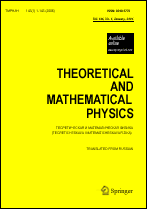|
Tetrad-gauge theory of gravity
L. P. Shevchenko
Department of Power Industry, Machine Building, Mechanics,
and Control Processes, RAS, Moscow, Russia
Abstract:
We present a tetrad–gauge theory of gravity based on the local Lorentz group in a four-dimensional Riemann–Cartan space–time. Using the tetrad formalism allows avoiding problems connected with the noncompactness of the group and includes the possibility of choosing the local inertial reference frame arbitrarily at any point in the space–time. The initial quantities of the theory are the tetrad and gauge fields in terms of which we express the metric, connection, torsion, and curvature tensor. The gauge fields of the theory are coupled only to the gravitational field described by the tetrad fields. The equations in the theory can be solved both for a many-body system like the Solar System and in the general case of a static centrally symmetric field. The metric thus found coincides with the metric obtained in general relativity using the same approximations, but the interpretation of gravity is quite different. Here, the space–time torsion is responsible for gravity, and there is no curvature because the curvature tensor is a linear combination of the gauge field tensors, which are absent in the case of pure gravity. The gauge fields of the theory, which (together with the tetrad fields) define the structure of space–time, are not directly coupled to ordinary matter and can be interpreted as the fields describing dark energy and dark matter.
Keywords:
tetrad formalism, torsion, gauge field, gravity, dark matter, dark energy.
Received: 01.06.2016
Revised: 21.06.2017
Citation:
L. P. Shevchenko, “Tetrad-gauge theory of gravity”, TMF, 194:3 (2018), 522–546; Theoret. and Math. Phys., 194:3 (2018), 450–470
Linking options:
https://www.mathnet.ru/eng/tmf9240https://doi.org/10.4213/tmf9240 https://www.mathnet.ru/eng/tmf/v194/i3/p522
|


|




 Contact us:
Contact us: Terms of Use
Terms of Use
 Registration to the website
Registration to the website Logotypes
Logotypes








 Citation in format
Citation in format 